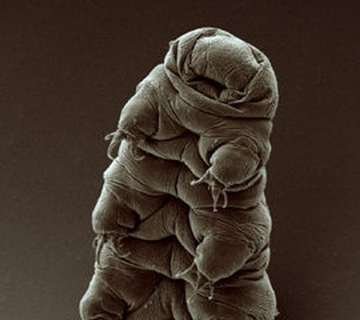
In the end, there will be tardigrades.
If a cataclysm wipes out most of life on the planet — including humans — it’s likely that tardigrades will survive. These oddly cute microscopic animals are among the toughest creatures on Earth.
Some can withstand the shock of boiling water and temperatures that near absolute zero. Others have survived in the crushing pressures of the deep ocean or go without water for decades. Tardigrades have survived in the vacuum of space. In 2014, Japanese researchers thawed a group of tardigrades that had been frozen for 30 years. What did they do after they woke up? They reproduced.
But, what would it take to ... kill them all? (Laughs maniacally.)
That’s roughly the question a group of physicists asked in a new paper in Nature’s Scientific Reports journal.
The point of the paper isn’t to pick on tardigrades. Rather, it’s a thought experiment.
“Much attention has been given in the literature to the effects of astrophysical events on human and land-based life,” the authors, physicists from Oxford and Harvard, write. “However, little has been discussed on the resilience of life itself.”
This question is important because if a mass extinction event were to occur, it would be nice to know if life could again grow, evolve, and prosper. The asteroid impact that killed the dinosaurs 66 million years ago also took out 80 percent of the other species on the planet. But some small mammals survived. And that’s why we’re here today.
Tardigrades are good benchmark on this question. If the extremely tough tardigrades go, then, the Earth, in the word of the researchers, would be “sterilized” of all life.
It’s important to note: Tardigrades are basically indestructible only when they enter a special state called cryptobiosis.
In harsh environments, the animals tuck in their legs and expel all moisture from their bodies. In this state, they're called tuns.
As tuns, the tardigrades produce glycerol (antifreeze), and secrete trehalose, a simple sugar with remarkable preservation properties. "Trehalose is viewed as a cocoon that traps the biomolecule inside a glassy matrix, like amber-encasing insects," explains a 2009 paper in Protein Science. When the trehalose crystalizes, the tardigrade becomes mummified in a glass suit of armor. As a tun, the tardigrade reduces its metabolism by 99.99 percent as it waits for a more suitable environment.
Different species of tardigrades have different adaptations for a wide variety of environmental threats. In hot conditions, they release heat-shock proteins, which prevent other proteins from warping. Some tardigrades can form bubbly cysts around their bodies. Like puffer jackets, the cysts allow them to survive in harsh climates.
So what would it take? The researchers made some assumptions about tardigrades’ upper limit for heat and radiation exposure, and examined three scenarios.
In the case of 1 and 2 — hell would be unleashed on Earth. The radiation would destroy the ozone layer, fry all life on land, and destroying our oxygen-rich atmosphere. However, in these scenarios, the tardigrades could still survive. “Even the complete loss of the atmosphere would not have an effect on species living at the ocean’s floor,” the study authors note.
To really kill all the tardigrades — and all life on the planet — you’d need to vaporize the oceans. Which would take an incredible, incredible amount of energy.
560,000,000,000,000,000,000,000,000 joules of energy, the study’s authors compute. A joule is a measure of energy equal to the effort it takes to create one watt of power for one second. 560 septillion of them is “around a million years’ of total human energy production at current rates,” the authors note in The Conversation.
Luckily, there’s no star within striking distance that could produce such energy.
We’ve only seen them in other galaxies and are some of the most energetic events ever observed in the universe. Scientists are not so sure how or why they form.
Hi! I am a robot. I just upvoted you! I found similar content that readers might be interested in:
http://www.rocketnews.com/2017/07/tardigrades-are-the-toughest-animals-on-earth-what-would-it-would-take-to-kill-them-all/
Downvoting a post can decrease pending rewards and make it less visible. Common reasons:
Submit
Congratulations @ejamz! You have received a personal award!
Click on the badge to view your Board of Honor.
Do not miss the last post from @steemitboard:
SteemitBoard World Cup Contest - Quarter Finals - Day 2
Participate in the SteemitBoard World Cup Contest!
Collect World Cup badges and win free SBD
Support the Gold Sponsors of the contest: @good-karma and @lukestokes
Downvoting a post can decrease pending rewards and make it less visible. Common reasons:
Submit
Congratulations @ejamz! You received a personal award!
You can view your badges on your Steem Board and compare to others on the Steem Ranking
Vote for @Steemitboard as a witness to get one more award and increased upvotes!
Downvoting a post can decrease pending rewards and make it less visible. Common reasons:
Submit